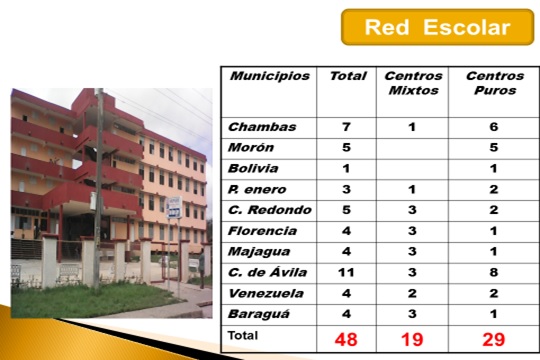Secondary Education
“(...) our education has an universal character: it has been created, constituted and developed for the benefit of all the children in the country. We have to take care of all of them, we have to educate them, we have to teach them what can be taught. To each and every one of them!
Fidel Castro Ruz, february 5th,1987
The Basic Secondary School is a part of the national education system that is constitutionally mandatory. It comes after the elementary education and it is followed by the upper secondary education (pre-university, technical and professional education or pedagogical school) includes the seventh, the eighth and the ninth grades.
The seventh grade is the beginning of the new teaching, where the contents of the previous level are systematised and new ones are introduced. During the two otheryears, new subjects are studied and the students get prepared for the pre-university or technical education. At the end of the ninth grade, students decide their continuity of studies for the acquisition of a profession depending on their social needs, interests and real possibilities.
The secondary education aims at the basic and integral formation of the Cuban adolescent, based on a general culture that allows him to be fully identified with his nationality and patriotism. Knowing and understanding your past will allow you to face your present and future preparation, in order to consciously adopt the option of socialism, which guarantees the defense of social conquests and the continuity of the work of the revolution,either in their ways of feeling, thinking and acting.

In the province of Ciego de Ávila, known as the city of portals and cradle of the Cuban locution, the secondary school is directed by a provincial methodological team composed of 9 methodologists of the different subjects and a Head of Department, who has subordination with their counterpart methodological teams in the municipalities of Chambas, Morón, Bolivia, First of January, Ciro Redondo, Florence, Majagua, Ciego de Ávila, Venezuela and Baraguá.
The total enrollment is 12 410 students, with 10 487 in urban areas, 441 of them in urban Turquino and 1 311 in rural areas. 170 of those of rural Turquino are distributed in 388 groups. 4 370 students receive the school snackand 1,243 have lunch in school canteens.
There are nine students facilities, 8 of themare Pioneer Palaces and one Pioneer Camp located in the municipality of Majagua
What shall we do?
- The improvement in the educational level.
- Completion of the coverage of teaching staff and the attention to alternatives.
- Perfeccionar la preparación de los docentes, para elevar la calidad de la clase y lograr la solidez de los conocimientos en los educandos, a través de: la auto preparación el trabajo metodológico y la superación profesional.
- To improve the teacher's preparation in order to increase the quality of the class as well as to achieve the solidification of the students' knowledge, through self-preparation, methodological work and professional development.
- The preparation of municipal structures and educational institutions, specially of the the heads of the differet years.
- The effectiveness of the vocational training and career guidance processes, with emphasis on pedagogical specialties (Basic Secondary Teacher). Correct functioning of the pioneer facilities.
- The teaching of the History of Cuba, Civic Education and the study of the work of Martí, Fidel and Raúl.
- Ideological and political work. The work with the OPJM.
- The use of audiovisual and computer materials from the classroom and complementary activities.
- Strengthening of the preventive work to achieve comprehensive attention to students and reduce incidents. (Functioning of the group pedagogical group).
- Life task
Laboratory operation - The school organization in the educational institution. (School snack process)
- II International Workshop of Basic Secondary. "For an Inclusive School".
Where are we going?
- To keep the stability of directors, teachers and specialists.
- To increase the effective development of the methodological preparation and the teacher's praparation improvement for a higher quality of the class, the application of the assessment, the use of audiovisuals materials, the fostering of values and vocational and labor training.
- To improve thepedagogical training processes through the search for new alternatives.
- Continuity of study of the 9th grade graduates from the Basic High School teacher's career.
- To improve the attention to the population in order to increase the quality of the service we offer, with the implementation of procedures conceived by the educational level.
- To reduce complaints and report with total or partial reason of the Educational System.
- To consolidate preventive work on the basis of a correct characterization of the school and educational strategies that have an impact on the incorporation of absent students for more than 15 days.
- To consolidate Vocational Training, Vocational Guidance and Job Training based on achieving continuity of studies of 100% of students.
- To perfect the direction of learning English.
- The effective use of science laboratories, computer science and Work Education workshops.
- .Mastery of the Martí's texts, as well as the revolutionary thought of Che and Fidel.
- Raise the results in national and Olympic competitions

